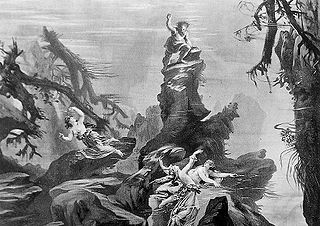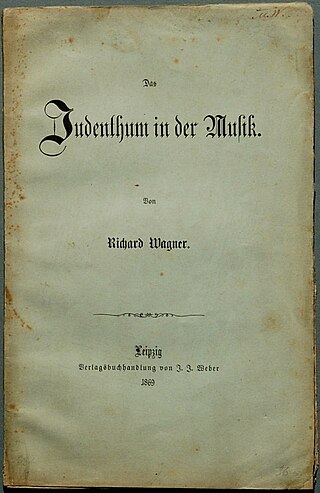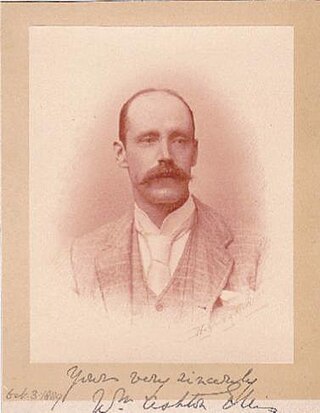
Wilhelm Richard Wagner was a German composer, theatre director, polemicist, and conductor who is chiefly known for his operas. Unlike most opera composers, Wagner wrote both the libretto and the music for each of his stage works. Initially establishing his reputation as a composer of works in the romantic vein of Carl Maria von Weber and Giacomo Meyerbeer, Wagner revolutionised opera through his concept of the Gesamtkunstwerk, by which he sought to synthesise the poetic, visual, musical and dramatic arts, with music subsidiary to drama. He described this vision in a series of essays published between 1849 and 1852. Wagner realised these ideas most fully in the first half of the four-opera cycle Der Ring des Nibelungen.

Der Ring des Nibelungen, WWV 86, is a cycle of four German-language epic music dramas composed by Richard Wagner. The works are based loosely on characters from Germanic heroic legend, namely Norse legendary sagas and the Nibelungenlied. The composer termed the cycle a "Bühnenfestspiel", structured in three days preceded by a Vorabend. It is often referred to as the Ring cycle, Wagner's Ring, or simply The Ring.

"Das Judenthum in der Musik" is an essay by Richard Wagner which attacks Jews in general and the composers Giacomo Meyerbeer and Felix Mendelssohn in particular. It was published under a pseudonym in the Neue Zeitschrift für Musik (NZM) of Leipzig in September 1850 and was reissued in a greatly expanded version under Wagner's name in 1869. It is regarded by some as an important landmark in the history of German antisemitism.
A leitmotif or Leitmotiv is a "short, recurring musical phrase" associated with a particular person, place, or idea. It is closely related to the musical concepts of idée fixe or motto-theme. The spelling leitmotif is an anglicization of the German Leitmotiv, literally meaning "leading motif", or "guiding motif". A musical motif has been defined as a "short musical idea ... melodic, harmonic, or rhythmic, or all three", a salient recurring figure, musical fragment or succession of notes that has some special importance in or is characteristic of a composition: "the smallest structural unit possessing thematic identity".

Giacomo Meyerbeer was a German opera composer, "the most frequently performed opera composer during the nineteenth century, linking Mozart and Wagner". With his 1831 opera Robert le diable and its successors, he gave the genre of grand opera 'decisive character'. Meyerbeer's grand opera style was achieved by his merging of German orchestra style with Italian vocal tradition. These were employed in the context of sensational and melodramatic libretti created by Eugène Scribe and were enhanced by the up-to-date theatre technology of the Paris Opéra. They set a standard which helped to maintain Paris as the opera capital of the nineteenth century.

A Gesamtkunstwerk is a work of art that makes use of all or many art forms or strives to do so. The term is a German loanword accepted in English as a term in aesthetics.

François Antoine Habeneck was a French classical violinist and conductor.

The evolution of Richard Wagner's epic operatic tetralogy Der Ring des Nibelungen was a long and tortuous process, and the precise sequence of events which led the composer to embark upon such a vast undertaking is still unclear. The composition of the text took place between 1848 and 1853, when all four libretti were privately printed; but the closing scene of the final opera, Götterdämmerung, was revised a number of times between 1856 and 1872. The names of the last two Ring operas, Siegfried and Götterdämmerung, were probably not definitively settled until 1856.

The German composer Richard Wagner was a controversial figure during his lifetime, and has continued to be so after his death. Even today he is associated in the minds of many with Nazism and his operas are often thought to extol the virtues of German nationalism. The writer and Wagner scholar Bryan Magee has written:
I sometimes think there are two Wagners in our culture, almost unrecognizably different from one another: the Wagner possessed by those who know his work, and the Wagner imagined by those who know him only by name and reputation.

"Art and Revolution" is a long essay by the composer Richard Wagner, originally published in 1849. It sets out some of his basic ideas about the role of art in society and the nature of opera.

"The Artwork of the Future" is a long essay written by Richard Wagner, first published in 1849 in Leipzig, in which he sets out some of his ideals on the topics of art in general and music drama in particular.
"Music of the Future" is the title of an essay by Richard Wagner, first published in French translation in 1860 as "La musique de l'avenir" and published in the original German in 1861. It was intended to introduce the librettos of Wagner's operas to a French audience at the time when he was hoping to launch in Paris a production of Tannhäuser, and sets out a number of his desiderata for true opera, including the need for 'endless melody'. Wagner deliberately put the title in quotation marks to distance himself from the term; Zukunftsmusik had already been adopted, both by Wagner's enemies, in the 1850s, often as a deliberate misunderstanding of the ideas set out in Wagner's 1849 essay, The Artwork of the Future, and by his supporters, notably Franz Liszt. Wagner's essay seeks to explain why the term is inadequate, or inappropriate, for his approach.
Wieland der Schmied is a draft by Richard Wagner for an opera libretto based on the Germanic legend of Wayland Smith. It is listed in the Wagner-Werk-Verzeichnis as WWV82.

Theodor Uhlig was a German violin-player, composer and music critic. He was the illegitimate son of Frederick Augustus II of Saxony.
"Eine Mitteilung an meine Freunde", usually referred to in English by its translated title of "A Communication to My Friends", is an extensive autobiographical work by Richard Wagner, published in 1851, in which he sought to justify his innovative concepts on the future of opera in general, and his own proposed works in particular.
Richard Wagner's "Autobiographic Sketch" was written in 1842. It is the composer's earliest autobiographical account.
Alexander Müller was a German pianist, teacher, conductor and composer.

Wieland der Schmied(Wieland the Smith; Slovak: Kováč Wieland) is an opera in three acts by Ján Levoslav Bella first performed in 1926, to a libretto by Oskar Schlemm based on an original libretto draft by Richard Wagner.

William Ashton Ellis was an English doctor and theosophist. He is remembered for translating the complete prose works of Richard Wagner.












